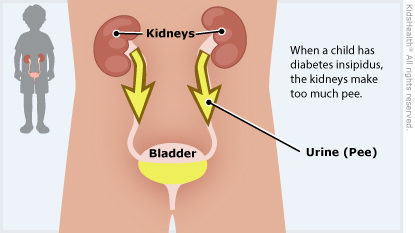Nephrogenic Diabetes Insipidus: How to Care for Your Child
In nephrogenic (nef-reh-JEN-ik) diabetes insipidus, the body loses too much water because of a problem with the kidneys. Normally, the kidneys help balance the amount of water and salt in the body. A child with nephrogenic diabetes insipidus may pee a lot, wet the bed, be thirsty often, or get dehydrated. Changing the diet and taking the recommended medicines can help.


-
Fill all prescriptions and follow the instructions for giving medicines.
-
Let your child drink whenever thirsty.
-
Your child should be encouraged to pee often (about every 2 hours) and empty the bladder completely.
-
If an ultrasound shows that the bladder isn't emptying completely, your child may need to do double voiding to make sure the bladder empties completely. Double voiding means going back to the toilet to pee a second time.
-
If your child is an infant, you may need to add water to your baby's feedings. Offer your baby something to drink every 2 hours during the day and night, and if they wake up during the night.
-
Go to all follow-up doctor visits.

Your child:
-
is cranky and hard to comfort
-
has less energy than usual
-
has a fever of 100.4°F (38°C) or higher
-
has muscle cramps
-
is vomiting or refuses to drink

Your child:
-
has a seizure
-
has a severe headache
-
is extremely sleepy or hard to wake up
-
is confused
-
seems dehydrated; signs include dizziness, drowsiness, a dry or sticky mouth, sunken eyes (or sunken soft spot on an infant's head), crying with little or no tears

Is nephrogenic diabetes insipidus the same as diabetes mellitus? Nephrogenic diabetes insipidus is not the same as diabetes mellitus ("sugar diabetes"). Although the body may make too much pee in both conditions, the two are different and need different treatment.
How does nephrogenic diabetes insipidus happen? Nephrogenic diabetes insipidus often runs in families and is caused by genetic mutations (changes). It also can happen if a child has another health problem or takes some types of medicines. Health care providers do testing to learn more about the cause.
How is nephrogenic diabetes insipidus treated? Health care providers may refer a child to a specialist. Treatment includes medicine and sometimes a low-salt diet. These can help the body make less urine. If another health problem is causing diabetes insipidus, the health care provider will treat it.